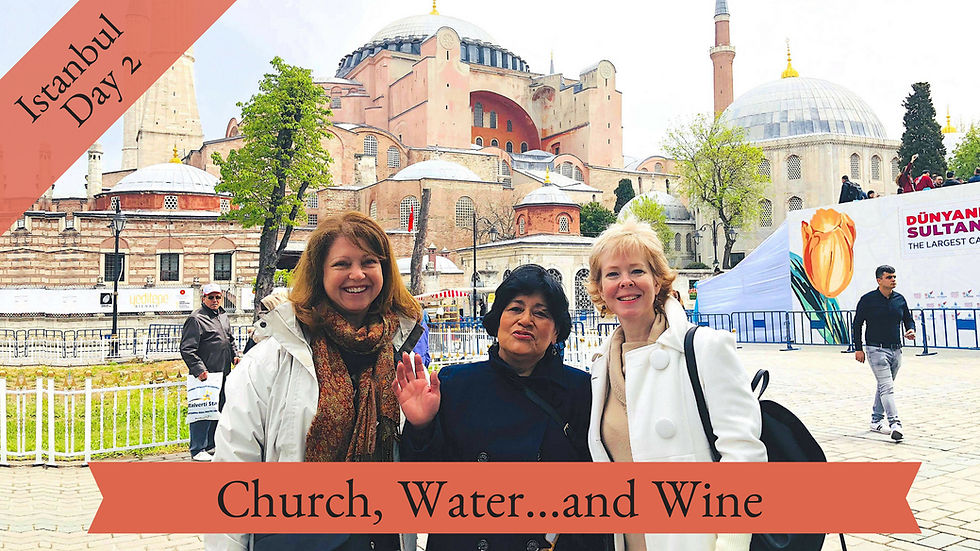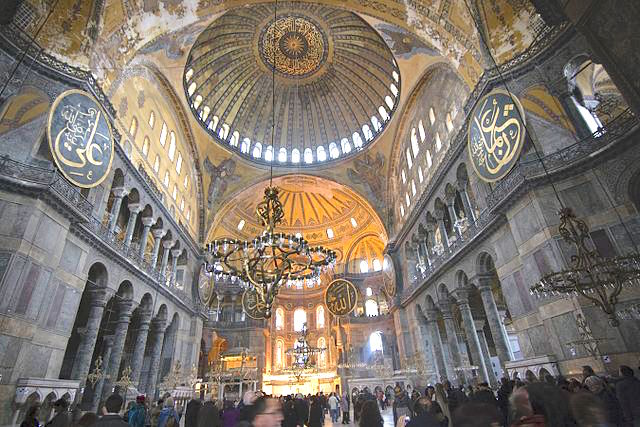Istanbul Trip Day 2: An Experience of Church, Water...and Wine
- Ginger Monette
- Jun 17, 2018
- 5 min read
Updated: Oct 18, 2020

**If you missed my Istanbul Day 1 post about a madcap adventure in search of Kuzey, Cesur, and Behlul, be sure to read it here.
Church, water, and wine. Did I have some sort of spiritual experience on day 2 of the Turkish Drama Appreciation Group’s tour of Istanbul? Not exactly. So, what’s with the title, you ask? Read on!
Church--one of the most magnificent in the world: The Hagia Sophia
On my second morning in Istanbul at the appointed time, the fifty or so of us on the tour divided into four groups and set out with our guides from the Doubletree Hilton. Our hotel was conveniently located in the heart of Istanbul's historical peninsula and an easy walk to the Hagia Sophia and other sites.
As we trekked through this lively, touristy area, we passed a plethora of Turkish cafes and interesting shops whose owners stood at their doors and beckoned us inside. Among the Turks, Arabs, Asians, and other assorted tourists bustling on the sidewalks, I couldn't help but notice the number of women wearing some sort of religious attire—from fashionable printed headscarves all the way to full black burkas. This cultural aspect of Istanbul is something our Turkish dizis rarely reveal.
As we rounded a corner into the Hagia Sophia plaza, I was a bit taken aback by the two police officers armed with sub-machine guns. It was a sober reminder that tourist-magnet sites like the Hagia Sophia can also be potential targets for terrorists. But aside from their presence, I felt perfectly safe as we mingled in the lovely open plaza situated around a large fountain. The plaza also featured a gorgeous tulip “carpet” which served as an impressive reminder of Turkey's centuries-old love affair with tulips.
Once our guide secured our Hagia Sophia tickets, we passed through a security checkpoint and then entered the church-turned-mosque museum. And what an entrance it is. Two enormous bronze and oak doors 23 feet [7 meters] tall open into the magnificent space whose domed ceiling soars some 180 feet [55 meters] from the floor. I knew it would be beautiful—photos had prepared me for that. But I wasn't prepared to be so thoroughly awed by its grandeur and the sheer enormity of the space. As I gazed around its massive interior, I felt no bigger than a tiny mouse on the floor of a mansion.
I marveled at the intricate gold mosaics depicting Biblical scenes that attest to the structure's Christian roots. The enormous framed disks inscribed with names of Allah and his prophets are evidence of its nearly 600 years as a mosque. But all of its architecture, stonework, and patterned décor speak of the skills of Middle Eastern architects, craftsmen, and artisans over a span of 1,500 years.
Next we followed our guide up a steep cobbled ramp to the second floor gallery where we viewed more Biblical mosaics up close and looked down onto the main floor. We stood in a special spot just above the doors that had once been reserved for the Sultan’s wife to afford her a panoramic view of the her husband and all the festivities below. (Hover over photos for description.)
So what's the history behind this magnificent church-turned-mosque-now-museum? This short video tells just enough to satisfy without overwhelming.
After enjoying coffee in the museum's outdoor cafe, we headed to the site of the Great Hippodrome. Not much remains there now except a few leftover relics from its days of glory nearly 1,000 years ago, but I was particularly interested as I had done quite a bit of research on what had once been a magnificent outdoor arena similar to the great coliseum in Rome. You can read all about it on my Great Hippodrome blog post here.
Water--Over 17 MILLION gallons! The Basilica Cistern
We made a brief stop at the Blue Mosque and toured the courtyard (the mosque itself was closed for renovation), then made the short walk to the Basilica Cistern. Fifty-two stone steps took us underground into to a massive 'cathedral,' ingeniously constructed as a storage 'tank' for fresh water. Why do I refer to it as a cathedral? Because its beautiful, arched ceiling and stone support columns are reminiscent of typical cathedral architecture.
It was cool and dark down there, but I don't recall it feeling particularly damp or smelling musty in spite of the foot or so of water still remaining. As we strolled along the catwalks that wound through the cavern, I once again marveled at the ingenuity and skill of the emperor's engineers.
Some 1,500 years ago, Constantinople faced a monumental problem—water. Fresh water. Although the city was surrounded by water, it only produced a limited supply of drinking water for its burgeoning population of nearly a half a million people. The engineers' solution? Construct more than 400 miles of aqueducts and 150 massive cisterns. The Basilica Cistern is the largest and holds the equivalent of twenty-seven Olympic-sized swimming pools. That's a LOT of water! And rather than go to the expense of mining the stone needed for 336 support columns, they pillaged them from Greek and Roman temples—a bummer for future historians, but easy on the emperor's wallet.
Ok, I admit, I'm a history geek. And just because it is so darn interesting, 90 seconds of this video starting at 9:25 tells how the Basilica Cistern was constructed and how it solved their water problem. (If you start at 6:30 you'll learn about the aqueducts as well.)
When we emerged above ground again, we realized three ladies in our group were missing. They'd stopped to have “The Ottoman Experience” available at the exit of the cistern. A professional photographer offered customers the opportunity to dress in regal Magnificent Century era costumes and pose for keepsake photos. While waiting for them, the rest of us became fast friends chatting on the street corner and eating roasted chestnuts purchased from a street vendor.

Wine--by the glass: Dinner at an outdoor cafe
After a stop at Gülhane Park to admire the resplendent flower 'carpets,' the whole tour group met up for dinner at an outdoor cafe. Over Turkish kebabs and a glass of wine, tables buzzed with chatter as we shared our discoveries and favourite moments of the day.
As much as I enjoyed the historical sites, I enjoyed my newfound friends even more. It was fantastic to be among fifty others who all share my passion for Turkish Drama—a phenomenon most of the English-speaking world has yet to discover. So although visiting the Hagia Sophia, site of the Great Hippodrome, and Basilica Cistern wasn’t a ‘spiritual experience’ per se, the friendships formed and wonderful memories will last into eternity.
* * *
Photo credits: Photos of historical sites were either taken by me or are public domain from Wikimedia Commons. Other photos were used with permission from their owners.
Copyright @ 2018 Ginger Monette Article reprint policy
Postscript:
-Don't miss my upcoming Istanbul Day 3 post--"Kivancing." Subscribe to my Turkish Drama blog in the red box on the sidebar now! (Update: You can now read about it here!)
-If you missed my Day 1 post Desperately Seeking Kuzey...and Cesur and Behlul, be sure to read all about the madcap adventure here!
-Other related articles: Istanbul's Great Hippodrome and History of Turkey for Turkish Drama Lovers.
-Let's connect on Twitter! 99% of all posts are original material.

























